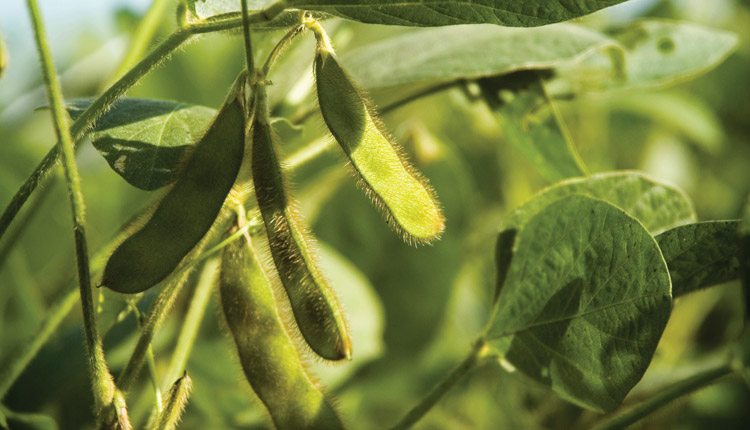Experts weigh in on how this crop is making its mark in the West and what retailers should know to help customers thinking of growing it.
EDITOR’s NOTE: Retail Roundtable is an essential new print and digital tool to help people who sell seed get the knowledge they need to better serve their customers. Got an idea for a topic? Email us at mzienkiewicz@issuesink.com with the subject line Retail Roundtable!



Germination: From a popularity perspective, what distinguishes soybean from other major crops grown in Western Canada, like, say, wheat? Why grow soybeans at all in a province like Saskatchewan?
Elroy Cober: Soybean production in Canada is one of continuously expanding to shorter-season areas. Soybean cultivars are regionally adapted. Individual cultivar movement north-south is primarily limited by day length responses and season length, and as a result we see strips of adaptation, or maturity zones, running east-west. Since soybean is a short-day plant — that is, it matures fastest in short days — moving north results in more delay from longer days, and generally shorter growing seasons. This is in contrast to wheat, a long-day plant, where moving north speeds maturity and helps fit it into the shorter season.
Tom Warkentin: People might consider growing soybeans in Saskatchewan/on the shorter-season Prairie for several reasons. First, we have a need for more nitrogen-fixing crop options. Pea and lentil are grown widely, some chickpea and a little faba and common bean, but if you look at the annual planted area of crops in Saskatchewan, we’re only at about 15 per cent nitrogen-fixing crops. Soybean can fit in as an option.
We know there are large markets for soybean internationally, so that’s a plus. I see soybean as relatively easy to grow and harvest in comparison to lentil or chickpea.
In recent years we’ve struggled a bit with root rot in pea and lentil in wetter seasons. We know soybean is resistant to Aphanomyces, which is an issue in pea and lentil. Also, there are lots of herbicide options in soybean for weed control.
Germination: Any reasons for not growing soybean?
TW: In general soybean is a long-season crop, so that’s obviously a factor here on the Prairies. It’s somewhat drought susceptible. In some ways the seed is expensive, which can be an issue for some.
Germination: What do growers have to consider when deciding to grow soybean or not? How can they know what the best variety for them might be?
EC: When making soybean variety selections for your farm, you need to start with a realistic maturity for your location. Then factor in your risk tolerance for frost, recognizing you will win with a later maturity variety in an open fall but lose with an early frost. Look at the pool of varieties adapted within your chosen maturity. Avoid the temptation to look at those higher yielding varieties further down the chart. Use actual days to maturity from your multiple location regional trials to judge maturity. While yield is important, remember to take other factors into consideration. You might need disease-resistant or iron deficiency chlorosis-tolerant varieties. Seed composition may be an issue for you if there is a way to capture that value in an identity preservation system. Also, do you have the equipment and marketing infrastructure to grow soybeans?
Brad Pinkerton: People often ask about yield. It’s hard to have a comparison with every single variety out there. Doing your research is crucial, and retailers can be an asset in helping them. We get a lot of questions about disease. In 2016 it was white mold. In 2017 it was iron chlorosis. Some years we get questions about Phytopthora root rot ratings. Farmers and retailers want to hear how others farmers did with a variety; testimonials are always in demand. I caution that just because one person had a good experience in an area doesn’t mean that variety is a winner.
Germination: Once they determine that they want to grow soybean, what are some ways they can pick the best variety for them?
EC: They should determine what maturity they’re comfortable with, the season for their farm, tolerance for loss to frost — then look at a pool of varieties that fit into that maturity. They’ll also want to look at yield. Then there are the non-yield issues, possibility of iron deficiency chlorosis, or maybe they need herbicide tolerance traits for their cropping system.
Germination: How can retailers best inform farmers about variety specifications?
BP: What sort of information I want to push out to whoever is asking the questions always challenges me. Everyone has different levels of acceptability for different kinds of information. Reps, salespeople and farmers may or may not find the same data acceptable. More and more I hear that private data is biased. Even though I hire out third party researchers to do trials, the yield charts are seen as biased. More often I choose to use yield data from third party seed guides — farmers see it as the best data.
Germination: How do you as a rep familiarize yourself with new varieties?
BP: I get my feet on the ground and run four or five locations of replicated trials, spend time with the new genetics, and I depend heavily on seed grower testimonials. They tell me what went wrong and what they liked about the products. The key is to share that information with my growers and retailers to help build confidence. Information sharing has to include the good, bad and ugly. As a team, my retails and myself can figure out where a product fits best, or doesn’t fit at all. I’ve had varieties that looked amazing on paper but failed out in the real world.
Germination: How can growers make the most of the soybean section in their favourite seed guide?
BP: You need to always need to make sure the data is as close to you as possible. We see significant differences in how a product will yield in the Red River valley versus Yorkton or Boissevain. Make sure the data you’re looking at is as close as possible to your region and is over multiple locations — you can’t look at just one or two yield locations.
Germination: There’s talk of soybeans in Alberta. What’s the future there?
EC: Canada has a history of soybean expansion West and northward. Starting from two counties in southern Ontario, we have seen expansion through Ontario, Quebec and now Manitoba. Who knows how much soybean can expand in Saskatchewan and Alberta? As far as breeding for these regions is concerned, we have to balance between too dry in the Palliser Triangle and too short a season as we move north.
TW: There’s interest there on the research side and on the part of some growers. Right now the acreage is small. It should be a good fit in the irrigation district where you can rule out drought, but it would mean a compromise between picking soybeans over some of the higher value crops that are grown there.












